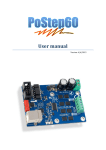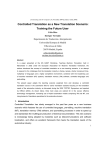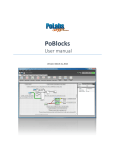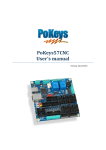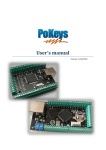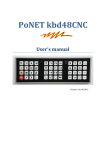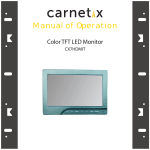Download PoStep25 User`s manual
Transcript
PoStep25 user’s manual initial release (26.11.2011) PoStep25 User’s manual WARNING! Do not connect or disconnect a motor while the driver is energized. This could cause permanent damage to the driver! Description The PoStep25 is a high performance, cost effective stepping motor driver to implement intelligent stepping motor control. The driver incorporates an advanced architecture and surface mount technology to achieve an exceptional power density. PoStep25 FEATURES 0.5 to 2.5 Amps Phase Current SImple current setting with jumper Compatible with 4, 6, and 8 wire stepper motors of any voltage +10 VDC to +27 VDC Power Supply 1, 2, 4 and 16 Micro-steps per Step Mixed decay mode for smoother moving of motors 3,3V and 5V logic compatible inputs 500 KHz Max Step Rate 0 °C To 70 °C Operating Temperature LED Power and Enable Indicator Small Size: 50 mm X 52 mm Board use requirements Step, direction and enable inputs. 10-27 VDC power supply, connected bipolar stepper motor before applying power. Connection and setting 1. Mount the PoStep to the stable surface. If PoStep25 will be mounted to metal surface, please isolate it. 2. Set microsteping swithch to required microstepping multiplier according to printing on the driver 3. Put current limit jumper to required position: 0,5A, 1A, 1,5A, 2A or 2,5A 4. connect step, direction, enable and GND to PoStep25 from your controller or BOB 5. Connect power supply www.poscope.com PoStep25 user’s manual initial release (27.11.2011) 10 pin IDC connector pinout Pin 1 3 5 2, 4, 6, 7, 8, 10 9 Function Enable (1=enable, 0=disable) direction step GND Not connected Motor connections Note: To avoid damaging, make sure the phase winds are connected correctly. Resistance between leads of different phases is usually > 100KΩ. Resistance between leads of the same phase is usually < 100Ω. The drive will work with 4-wire, 6-wire or 8-wire stepper motors. 4-wire motors are truly bipolar, and can only be run as such. 6-wire motors can be wired two ways to work with the bipolar drive. The first is half-winding. In this method, one end wire, and the center-tap wire of the phase is used. The other end is insulated and left unused. This method uses unipolar nameplate current specifications, and will produce nameplate torque. The second is series winding. In this configuration, the center-tap is insulated, and unused. This method uses all of the wiring per phase, but has double the number of wire turns as halfwinding or unipolar mode. Because of this, the amperage requirement becomes half the nameplate rating. Because the wire in the coil can handle more current than ‘half’, motor manufacturers will often “boost” the torque rating by specifying currents up to 71% of unipolar rated current while running in series mode. This is fine for FULL step motor drives, but not necessarily so good for microstepping drives. Using this much can smear microstepping smoothness and accuracy. Any extra torque achieved by this method will generally be lost to machine vibrations due to loss of microstepping smoothness. The best performance will be somewhere between the 50% and 71% current rating. The advantage of using series winding is that lower power drives may be used. For example a unipolar motor rated for 4.0A/phase is over the 2.5A/phase maximum of the PoStep25. Running in series requires only 2.0A/phase to achieve the same torque. The disadvantage of this method is that it raises motor inductance, which in turn, slows motor coil charging time. Since proper torque is reached only when the coil has charged to the required level, the longer it takes to charge, the longer until full torque is achieved. This leads to slower full torque stepping rates. Conversely, a half-winding configuration requires full nameplate rated current, but if the drive is capable of this, the advantage is that rated torque can be achieved twice as fast as series winding (using the same voltage, when comparing half-winding and series). 8-wire motors can be run in paralell or serial mode. Parallel mode needs higher current, has lower inductance and better torque, Serial mode needs lower current and has lower torque. Please read also 6-wire motors. 2 www.poscope.com PoStep25 user’s manual 3 initial release (27.11.2011) www.poscope.com




